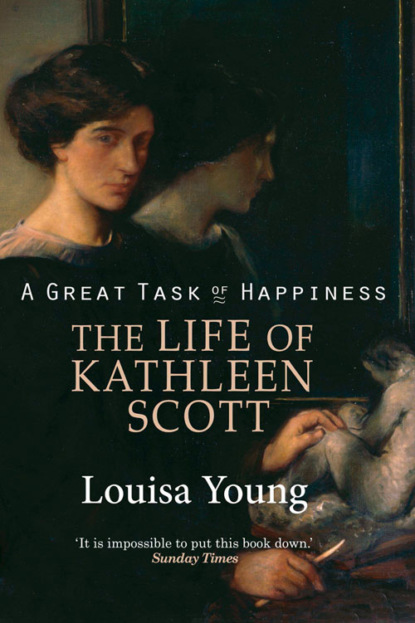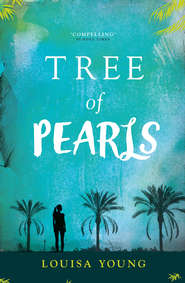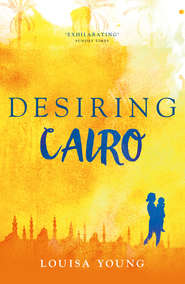По всем вопросам обращайтесь на: info@litportal.ru
(©) 2003-2024.
✖
A Great Task of Happiness: The Life of Kathleen Scott
Настройки чтения
Размер шрифта
Высота строк
Поля
everything and everybody seemed rather ugly and terribly wicked, but I was fully determined there must be no half measures. I must appear surprised at nothing. I must allow no one to suspect my pitiful ignorance, my still more pitiful innocence. When strange, unknown things happened, I registered them, but from no one did I ask an explanation, and of many things the explanation did not occur to me till twenty years later.
One such episode involved Madame from the pension. To Kathleen ‘this repellent woman was a formidable pillar of propriety and austerity’, but with hindsight perhaps she was not. ‘Madame slept on the ground floor, her window giving on to the street. I slept directly above this, and used to drag my bed across to the window to get the maximum of air. One night in the small hours I awoke, hearing a disturbance below. Looking down, I saw a quite young man jumping out of Madame’s window. “A burglar,” I thought, and was about to fly to the rescue when Madame’s head popped out of the window, pleading, noisily, “Ah, Marcel, si tu reviens, je te donnerai encore un louis!”’ (Marcel, if you come back, I’ll give you more money.) Very Anaïs Nin, but it made no sense to Kathleen.
One of the first things the convent girl with her bathtime chemises had to accept was the nude model. On her first day at Colarossi’s,
passing an open door of one of the studios, I saw Hermione standing at the back of the room near the door and went to join her. Hermione was standing composedly with her head critically on one side. At the end of the studio passed, one by one, a string of nude male models. Each jumped for a moment on to the model throne, took a pose, and jumped down. The model for the week was being chosen. Before reason could control instinct I turned and fled, shut myself into the lavatory, and was sick. How could my lovely Hermione stand there, so calmly appraising? How could she, how could she? Then I shook myself. ‘Fool! Puritan! They’ll guess how you feel if you’re not careful. Go back this moment and copy Hermione’s nonchalance, you vulgar little thing!’
To begin with Kathleen painted. Though there were classes for men and women together, she started out with the dames seules. It didn’t last. ‘What are these folks?’ she found herself thinking. ‘Middle-aged women eating their hearts out year in year out, and for what? In order that on some day of an impossible future she may have a picture in the Salon. In ten years I shall be like that. Exactly like that.’ The nickname for the dames seules was the ‘damned souls’. Enough! she felt, and packed up to leave.
As she was walking out of the building she heard the cheerful sound of Norwegians singing from another studio, and looked in to see what was going on. It turned out to be the sculpture class, and she thought it looked rather fun. So it was, once she had overcome the initiatory trauma of ‘tous les nouveaux payent un ponche’. This mysterious rule had been chalked up on the wall; there was also laughter (not entirely friendly) and looks (knowing, in her direction). ‘All the news pay a ponch,’ she thought. What on earth was a ponch?
Presently a courteous Norwegian approached me and said, ‘It is a custom that any new student stands punch to the others,’ and returned to his place. What an unexpectedly grim affair! How on earth was it to be done? Was I to take them to a café? Oh dear, this was terrible; and how much would it cost? Would I have the money? What a well-thought-out torture for a terrified puritan! There was only one other girl in the class, a German with lank hair. I was not going to consult her. While I hesitated, an ill-bred little Italian started in a half-singing drone ‘tous les nouveaux payent un ponche’. One by one took it up until a great chorus of it filled the room. Suddenly, nearly crying with uncertainty and my heart in my mouth, I too joined in the chorus. ‘Tous les nouveaux payent un ponche, je suis nouveau, je paye.’ [I am new, I pay.] A general bravo, and much good-humoured laughter.
The kind Norwegian arranged for the punch to be sent in from a café, and lent her the money to pay—six francs.
At a quarter to eleven someone called ‘c’est l’heure’ (It’s time). The model, an Italian youth, got down from the throne, stretched, yawned, and went over to the stove. The door opened, and a large bowl of steaming alcohol was brought in, and sixteen glasses. Thank goodness, there was enough to go round and some left for the model. Hoping so much I was looking quite normal and at my ease, I took my glass and tasted it. It was the first time in my life except at Communion that I had tasted alcohol, and rum was rather a stiff beginning. How it burnt! At Communion one had to take such a tiny sip of the horrid stuff, but this I must drink to the dregs. But no! As with my mutton fat, so with my rum. I found a way.
She seems to have forgotten, writing in 1932, ‘drinking champagne and being amusing while seeing Millicent off to Capri’ in 1901, but that one lapse with Millicent does seem to be the only time in her life that she found alcohol at all amusing.
Sculpture proved a success. Within three months she had a statue of a woman and child accepted for the Salon. Though in later life her portraits and larger-than-life public monuments were well known, it was her naked mothers and children, or fathers and children, which were the most beautiful and most touching of her work, the result of what she called ‘a tender quality’ which made them ‘personal and lovely’.
That early mother and child won her a medal and the desirable post of massier. The massier would select the model for the class, pose him (or her), stoke the fire and open the windows at lunchtime, and call ‘C’est l’heure!’ a quarter before every hour, for the model to rest. In exchange for these duties, the massier was relieved of class fees. To Kathleen this made a big difference. A reasonable estimate of expense for an unextravagant art student at the time was £95 per annum; she had but her £72. Her daily expenditure on food was:
Six francs on punch was nearly a week’s food allowance.
Once acclimatised, Kathleen and Eileen ‘made so bold as to emancipate ourselves, and took a tiny flat together’. Taking a flat was a symbol of freedom; the first step away from being one of the protected group of foreigners; an escape from the art student ghetto. Kathleen and Eileen had two rooms and a kitchen.
It was unfurnished, and so it really remained until the end of our tenure. The front room was small and light and looked on to a court; the back room was larger and dark. By common consent I was to have the small room and Jocelyn the dark room; but my room must serve as a sitting room and be kept neat. Very resourceful was I. A second-hand box mattress on the ground served for bed by night and seat for ourselves and our guests on the very rare occasions when we entertained. With a pot of blue paint I stained the floor and round the drab wall I hung posters. It sufficed. For several months we two lived together, but our friendship in no way developed.
Eileen used to visit Jessie in her rather grander quarters; Kathleen used to work, either at home or taking the evening classes at the studio. Most evenings she would eat quickly, cheaply and alone. ‘I almost always had my meals in the same restaurant. I took a book. I always sat at the same table. Opposite me, two tables away, sat a romantic-looking, upstanding, dark, very wavy-haired American artist, Edward Steichen, a photographer. He also brought a book.’
Steichen was the same age as Kathleen, the son of Lithuanians who had emigrated to Michigan. He was living in Montparnasse, studying, painting and photographing. At the time that Kathleen first met him he was doing a series of portraits for Alfred Steiglitz’s magazine Camera Work; and had photographed the artists Mucha and G.F. Watts, the symbolist poet Maeterlinck and the sculptor Rodin. His portraits are as far removed from the average turn-of-the century photograph as Robert Mapplethorpe’s are from a bulb catalogue. ‘There are certain things that can be done by photography that cannot be accomplished by any other medium, a wide range of finest tones that cannot be reached in painting,’ he wrote, and his photographs achieved them.
The question for Steichen was whether or not photography was art; Rodin and Maeterlinck believed that Steichen’s work proved that it was. Rodin wrote, ‘I consider Steichen a very great artist and the leading, the greatest photographer of the time,’ and Steichen wrote proudly to Steiglitz in 1901 that Rodin had described one of his pictures (Self-portrait with brush and palette) as ‘a remarkable photograph and a remarkable work of art—a chef d’oeuvre’. In 1906 Maeterlinck wrote an introduction to a volume of Steichen’s work, which he called ‘une admirable, une incomparable realisation d’art. Vous avez discipliné directement les rayons de soleil comme un peintre discipline ses pinceaux.’ [An admirable, incomparable work of art. You have exercised the same direct control over the rays of the sun as a painter exercises over his brushes.] In later years Steichen burnt all his paintings (all he could find) and became the highest-paid fashion photographer of his age, working with the US publisher Condé Nast and photographing society ladies such as Rita de Acosta Lydig, who used to tip her dressmaker with loose emeralds.
But in 1902 Steichen, with his ‘grey linen shirt with loose kimono sleeves, short turnover collar and black ribbon scarf at the throat’ and ‘hair of a significant length and degree of unkemptness’, as a press notice of the time described him, ate at the same cheap restaurant as Kathleen.
Day after day, [she wrote] lunch after lunch, dinner after dinner, for five months, we two sat opposite each other, scarcely ever looking up save to catch each other’s eye and look down again. Never once did we speak. Yet each knew when the other was gay or worried, had toothache or was happy. Even in those early days in Paris any student could talk to anybody he or she pleased, yet we two deliberately refrained. I knew his work. It was well known. It was good. One day, after not having seen him for a few meals, I overheard someone say ‘You know Steichen is going back to New York on Tuesday.’ ‘As soon as that, is it?’ was the uninterested reply. My heart beat preposterously. ‘He can’t go back on Tuesday. It’s Sunday today.’ Would he lunch at the restaurant on Monday? I went early with my book, Le Temple Enseveli by Maeterlinck. No waiting, no!—hardly had I settled in the usual place and ordered my meagre meal than Steichen passed me and sat down at his usual table. He glanced up at me with his usual half-smile, neither less nor more. Was he really leaving for America the next day?
I ate my lunch slowly, wondering would he not perhaps at last speak to me? He made no sign, so I got up and quietly crept to the door. As I paused at the caisse for change he came up behind me, and said very quietly: ‘You know, Esmeralda, that I’m going home tomorrow?’
Esmeralda—why Esmeralda? I never knew.
‘I know,’ I said, without turning my head.
In the street I found his tall figure walking beside me in a silence through which I dared not even look up at him. At long last he touched my yellow covered book.
‘What are you reading, Esmeralda?’ I showed him. ‘Oh, Maeterlinck, he’s good, stick to him. Well, goodbye.’
And he turned abruptly and went back towards his studio. I tore across the road to my school without looking back. What had I said—nothing. What had I looked like?—half-witted probably. Oh dear, oh dear!—his voice was gentler than I expected, and he was going away tomorrow.
There was dinner! Would he come to dinner? Probably not, he would be packing, but I went early…
He did come to dinner, in his cloak and wide-brimmed black hat, and as he left he mentioned that he happened to have a picture he’d taken of Maeterlinck, and would she like it? He knew where she lived, he said, and he’d drop it round later.
Kathleen spent the evening tidying her room, doing her hair, straightening her books, changing her dress, looking at her watch, wondering if he were making fun of her, wondering why she always thought people were making fun of her, imagining reasons why he wouldn’t come. And he came, and said things like, ‘What will become of you, Esmeralda?’ and ‘Why didn’t I find you before, Esmeralda?’ and ‘You oughtn’t to be here by yourself, you’re not like the others.’ Then he kissed her on the doorstep.
No notion had he that this was the first event of my prudent little life. The clouds of convent faith had long been dispersing—all but gone by now. Nevertheless I flung myself on my knees by the friendly old box-mattress. Glory and gratitude must be expressed to something. ‘… In the heights and the depths be praise!’ The odd thing is that it was all I wanted. I was glad, exhilarated, with the knowledge that he was going away. I was drunk with the joy that this one hour had come as the climax of those five months of reticence, and that it was finished. For four stormy years I was faithful to that hour.
Steichen returned to New York in 1902, the same year that Aleister Crowley, the notorious decadent and practitioner of black arts, first met Kathleen, according to his Confessions. Crowley’s view of Kathleen is wildly different to her description of her first kiss:
She was strangely seductive. Her brilliant beauty and wholesome Highland flamboyance were complicated with a sinister perversity. She took delight in getting married men away from their wives, and the like. . . Love had no savour for her unless she was causing ruin or unhappiness to others. I was quite ignorant of her intentions when she asked me to sit for her, but once in her studio she lost no time, and ‘The Black Mass’, ‘The Adepts’ and ‘The Vampire’ describe with ruthless accuracy our relations. She initiated me into the torturing pleasure of algolagny on the spiritual plane. She showed me how to intensify passion by self-restraint … She made me wonder, in fact, if the secret of Puritanism was not to heighten the intensity of love by putting obstacles in its way.
Either immediately after her first kiss with Steichen she changed from a chaste though romantic ex-convent girl into a practised pricktease, ‘a devil gloating on the pain’, ‘playing the whore’ to ‘her troth-plight lover’, with the blood of her victims ‘glittering a diadem upon [her] dazzling brows’, as Crowley described her in his poems, or their world views were simply miles apart.
The only point, which coincides, is that of ‘reticence’ and ‘restraint’. Kathleen was puritanical, partly by upbringing but enough too by personal taste that, as she shed habits of her upbringing, the puritanism remained. In particular, she was sexually puritanical. The reasons for this are manifold. It was the habit of her class, her sex and her time. She was romantic, insecure and self-protective. The most individual reason was her intensely idealistic attitude towards motherhood. Her passion for babies in general had matured into a particular passion for a particular baby—her future son. This was very important to her. Her ultimate interest in men was to find the one, the fine, heroic one, who would father the fine, heroic son of her dreams. She might flirt, fall in love, and have long and intense platonic relationships with men. Certainly young men became very worked up about her, but that does not prove that she had or did not have any physical relationship with them. She might, after her loyalty to Steichen had run its course, have run her fingers through their hair and let them kiss her, but she did not sleep with them. She was a virgin when she married, and by her own account her love for her husband took off on to new planes when her son was born.
All this need not preclude an intense unfulfilled sexuality. It is hard to know what Crowley meant by ‘algolagny on the higher plane’, but presumably it refers to Von Schrenk-Notzing’s term for sexual masochism, algolagnia (from the Greek algos, pain, and lagnos, lust). His suggestion of marriage-breaking may be a misdated reference to a later development in her friendship with Steichen, when in the early 1920s his wife (Clara Smith, whom he married in America in 1903) pretended to attempt suicide, and his attentions to Kathleen were cited as one reason for it. ‘Our affair’, Crowley wrote, ‘was too much ginger for the hoi polloi,’ but it sounds rather more that she wouldn’t have him. Although she mentions a great many people in her diaries, Crowley does not appear until 1930, when someone tells her he has become very fat and she is not at all surprised.
At the end of 1902 Kathleen was back in London on a visit. On 12 December she went to the Slade arts ball with Rosslyn and their friend Nigel Playfair. He tells (in Hammersmith Hoy) how he arrived late at the party having been to review a play, and found that Kathleen had broken her leg.
We brought her back to Gray’s Inn, [where Playfair lived] and sent for a doctor who promptly decided that she must stay where she was for at least six weeks. Her brother, most Jesuitically I thought, decided that he could return to his own rooms in Soho Square, Mrs. Brooks my housekeeper, plus a leg in plaster of Paris, being ample chaperonage, and there we were, a fortnight before Christmas. [Another version says that Rosslyn came back and stayed too.]
My own family were to spend the holidays in Hampshire, but I thought that I must not neglect my guest and that I would give a dinner party in her honour, she being by then able to hobble. But though her brother and Mabel Beardsley were available, there was nobody else free, and you can’t have a real Dickensian Christmas banquet for four. So it occurred to me to advertise for guests! And this is how I did it, in the columns of the Morning Post, to secure a reasonable social atmosphere. ‘A brother and sister’ (note trifling hypocrisy, but Queen Victoria was only just dead) ‘living in rather pleasant rooms near the Temple invite any ladies and gentlemen who may be lonely to dine with them on Christmas Day. All ladies must prefer Lewis Carroll to Marie Corelli and the gentlemen must not wear made-up ties. Reply box xxx.’
It does not seem very daring today, but the sensation this advertisement caused was immediate and tremendous. I think it was the Daily Telegraph had a leader on the subject, and I don’t think any, unless it were The Times, refrained from comment. We had over four hundred replies, written with varying wit, and we chose eight or ten guests who promised to be the most amusing, writing (a heavy labour) polite regrets to the rest.
They were so busy they forgot to order any food, so at the last minute a local restaurant, Café Roche, was asked to send in the dinner, and although Rosslyn had been busy in church from 5.30 that morning Nigel found it ‘a most amusing evening … we played snapdragon and charades and whatnot, and parted with vows of eternal friendship at two in the morning’.
When her leg was better Kathleen went to Spain with Hugo Law and his family. They were friends initially of Rosslyn—Hugo’s father, the Chancellor of Ireland, was a neighbour of the Bruces at Downhill. Kathleen thought Lota Law, Hugo’s wife, ‘the beautifulest woman of all’, and took to Hugo when he tried to teach her to drive. She had two pieces in the Salon in Paris and learnt that ‘the papers have given me some rather nice notices … what they really appreciate was done in three hours so I think I shall give up working very hard,’ as she wrote to Rosslyn. Despite a fever and her new resolution of laziness, she was busy on this holiday learning Greek and sculpting the friends who came to stay.
Back in Paris, the company Kathleen kept was pretty mixed. On the one hand were the British: Eileen and Jessie and cousin Hener Skene, who had arrived in Paris knowing no one but Kathleen, and who played the piano to her for hours on end. He soon entered into Paris life: he met Crowley, and introduced him to Isadora Duncan’s companion Mary Desti, who became Crowley’s lover and his ‘seeress’ under the name of Sister Virakam, and wrote a biography of Isadora. It was probably Kathleen who introduced Hener to Isadora (whom, as we shall see, she met through Rodin, and it could well have been Hener who introduced Kathleen to Crowley).
Hener had been in Vienna, ostensibly studying the piano with Leschetizky, though in fact he never met him. He had given away his lessons with the maestro to a German girl called Else: after three years she said, ‘You have compromised me,’ so he married her, shook hands at the church door and left her. ‘She was a better pianist than me,’ he said. (Willie Skene, who had by now ‘absquatulated to the colonies’, thought Hener’s marriage shocking, and that Hener should have been made to do more sport at school. ‘He would have learnt that… one can’t compete with anybody without training,’ he wrote pompously to Presh, which coming from him was a bit stiff.) Hener had discipline, though. On one occasion he locked himself into his room for a week with an enormous bunch of bananas, to prepare for a concert. He became Isadora’s pianist, playing with her all over Europe; Eileen and Jessie took him up too, but Kathleen could never forget the cat being bashed against the wall.
Other foreigners she knew at this time included Gertrude Stein, whom Rosslyn described as ‘a bookish American lady writer who talks and writes any way she likes, mixing her tenses and first and third persons at will’, and ‘her odd companion and sounding-board Alice B. Toklas’. Stein was rather taken with Kathleen: she described her (in the Autobiography of Alice B. Toklas) as ‘a very beautiful very athletic English girl, a kind of Sculptress, [who] had at that time no money to speak of either but she used to bring a half portion of her dinner every evening for Penelope.’ (Penelope was Isadora Duncan’s sister-in-law, who was then both pregnant and impoverished.) Kathleen knew Picasso too, slightly; she introduced him to Rosslyn, who sold him a terrier.
On the other hand were the French. Her closest French companion was a successful painter seven years her senior, named Hofbauer. He was suffering slightly from resting on his laurels and spending more time on the town than in his studio. ‘He had dozens of mistresses’, but Kathleen confounded any improper intentions by agreeing to meet him only at six in the morning for her daily swim in the Seine, and calling him a coward when he didn’t turn up. She would meet him for breakfast, for a dawn stroll in the Luxembourg Gardens or on the roof of Nôtre Dame (when she could persuade the custodian to let her up) but she wouldn’t meet him indoors or in the evening. He was rather embarrassed by it. What would his friends think of ‘this subjugation to a badly dressed anglaise with virginal tastes’, as Kathleen described it? Luckily they would never see them together, because they were always still asleep at the times Kathleen and Hofbauer met. And if they did see the couple together at six in the morning, they would assume they had spent the night together. Kathleen didn’t like to think of that, but recognized that it was unavoidable.
Hofbauer became jealous of Hener (‘Ha ha! That was it! There was a cousin!’) and started following Kathleen about. Finally he lost his temper, and she explained her reasoning: ‘I wanted to learn French, I’ve done that. I wanted to get you to work in the morning, you’ve done that. And I wanted to get our friendship on to a proper sort of foundation. We’ve done that.’ Later on when his laziness was again being a problem she borrowed Hener’s idea and locked Hofbauer in his studio every day, bringing him food and not letting him out until the day’s work was done. The painting he produced under this discipline won the Prix du Salon.
Her other French friends were Monsieur and Madame P (though Madame was in fact South American), at whose house she met writers and poets, Henri de Regnier, Paul Adam and Anatole France. ‘It was quite useless really, for my French was so poor that I dared not utter a word of it, and their French was so flashingly fast that I scarcely followed a word.’ The Ps were ‘rare friends’, ‘young, rich’, with ‘charm and wit’, her ‘skylight to a different Paris’. Kathleen introduced Eileen to the Ps—she had still not realised that her nervousness with Eileen and sense of inferiority were actually an unacknowledged dislike, and tried to please her with introductions and attentions. ‘I was baffled about Jocelyn, and made repeated efforts to disperse that intimate, slightly scoffing regard with which she seemed to look with mockery into the deepest recesses of my heart, and find there nothing but the commonplace and the trivial.’
She did, however, realise that it was time to get a place on her own, but not before Eileen had played a trick on her of dressing up as a boy. She announced the arrival of a cousin; could Kathleen entertain him for the evening because she Eileen was otherwise engaged? Certainly Kathleen could. She was completely taken in by the slender youth in a baggy Norfolk jacket, and when Eileen made her true identity known Kathleen’s reaction was mixed. She laughed, she claimed to have thought it was fun, but she felt sick too. Her love of her own freedom was always slightly charged by her distaste for the way the people around her in that easy-going milieu used theirs.
The day after Eileen’s trick Hener gave Kathleen vicious Chinese burns, demanding to know what had been going on. Eileen had sworn Kathleen to secrecy, so she didn’t tell. Hener got his own back by telling Kathleen that there was a Swede about who wanted to kill her, who was at that moment asleep in a drunken stupor on Hener’s studio floor. Hener had discovered him lurking with a revolver, threatening to shoot Kathleen. ‘What have you been doing to Sternstrom?’ Hener demanded. ‘He said he loves you, and that he is a god, and that it’s not fitting that a god such as he should be slighted. Later he wept and said you were so lovely you had better be killed before you got less so.’ Kathleen was less upset about the revolver (she knew about that anyway, and only hadn’t told Hener because she thought it might give him ideas) than about the drunken stupor. She decided to bolt to Chartres, where at night she read in her room at the Chariot d’Or, and by day communed with the statues on the west face of the cathedral, loving the stained glass, far away from ‘violent cousins, jealous painters, sinister Jocelyns and murderous Swedes’. Cathedrals gave her great pleasure. Such religious beliefs as survived her childhood had been waning for some time, but cathedrals were something else. ‘Could worship anything of which Cologne was emblematic,’ she wrote after a visit in August 1901.
When she got back to Paris she moved house.











